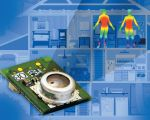 Because of their increasing importance to modern energy saving applications, contactless temperature technologies are showing significant growth. Traditional motion sensors like PIR detectors are increasingly being used in building automation systems to switch off lights, heating and air conditioning when rooms or floors are unoccupied – and this has breathed new life into a growth trajectory that had been levelling out. Gabriel Sikorjak of Omron Electronic Components Europe explains
Because of their increasing importance to modern energy saving applications, contactless temperature technologies are showing significant growth. Traditional motion sensors like PIR detectors are increasingly being used in building automation systems to switch off lights, heating and air conditioning when rooms or floors are unoccupied – and this has breathed new life into a growth trajectory that had been levelling out. Gabriel Sikorjak of Omron Electronic Components Europe explains
According to a 2012 report from the market research organisation Yole Développement, ‘Even if this motion detector business is mature, it will continue to grow at a significant rate (CAGR 2010-2016 in value: plus nine percent) driven by the concern for energy savings’. The overall IR detector business is predicted to expand from $152m in 2010 at a rate of +11% per year to reach $286m in 2016.
New infrared sensor technologies, capable of detecting stationary heat emitting objects, are able to take a larger share of the opportunities this brings – territory that is inaccessible to the familiar PIR detector. PIRs use the pyroelectric effect to sense people in its field of view and, as the pyroelectric phenomenon is a temporary change in a material’s structure during heating or cooling, the detection circuitry depends on measuring a difference in the heat pattern. It requires the source of infrared radiation to be non-static in order to detect presence.
 Absolute v relative
Absolute v relative
New thermal sensors based on microelectromechanical systems (MEMS) do not suffer this disadvantage. MEMS thermopiles, essentially nano-scale arrays of thermocouples, measure the actual temperature of the sources rather than a differential value, so are able to detect people in a room without requiring them to be moving. This opens new applications that pyroelectric sensors cannot touch.
For example they can be used as inputs to lighting, heating, air conditioning and security systems, reliably switching to energy saving modes when there are no people in the zone that is being monitored – and flagging alarm conditions when people should not be in that area.
As well as detecting presence or absence, new MEMS thermoelectric sensors can measure the actual temperature of the area they are monitoring. They can therefore provide inputs to HVAC systems allowing optimum control of the room environment. Moreover, by detecting sudden or unusual hotspots, they can flag a range of alert or alarm conditions such as potential fires, overheating equipment or leaks of hot fluids.
More accurate positioning
MEMS sensors measure temperature across the whole field of view – contrasting with conventional thermal sensors, which are restricted to measurements at a single point. Configured as an array (1 x 8 and 4 x 4 arrays are currently available), the sensor can assign temperature information to a specific cell, adding a positional dimension to its presence and temperature data. The result is higher accuracy, lower crosstalk and a wider field of view. Using multiple sensors in a room multiplies these benefits – a quad 4 x 4 array sensor module can be used to obtain higher resolution or broader coverage, for example identifying a person’s location within one metre across a 16m2 area.
The technology behind Omron’s D6T thermal sensors combines a MEMS micro-mirror structure for efficient IR radiation detection, with a silicon lens to focus the infrared rays onto its thermopiles. Proprietary application specific integrated circuits then make the necessary computations and convert sensor signals into meaningful digital outputs. All components were developed in-house and fabricated in Omron’s own MEMS facilities. The result is high ±1.5°C accuracy with noise immunity (measured as noise equivalent temperature difference) of 140mK.
Plans are in place to include the development of larger sensor arrays, with 16 x 16 MEMS sensors currently under development. These will provide capabilities approaching that of current low resolution thermal imagers.
Omron Electronic Components
T: 08447 111 111

